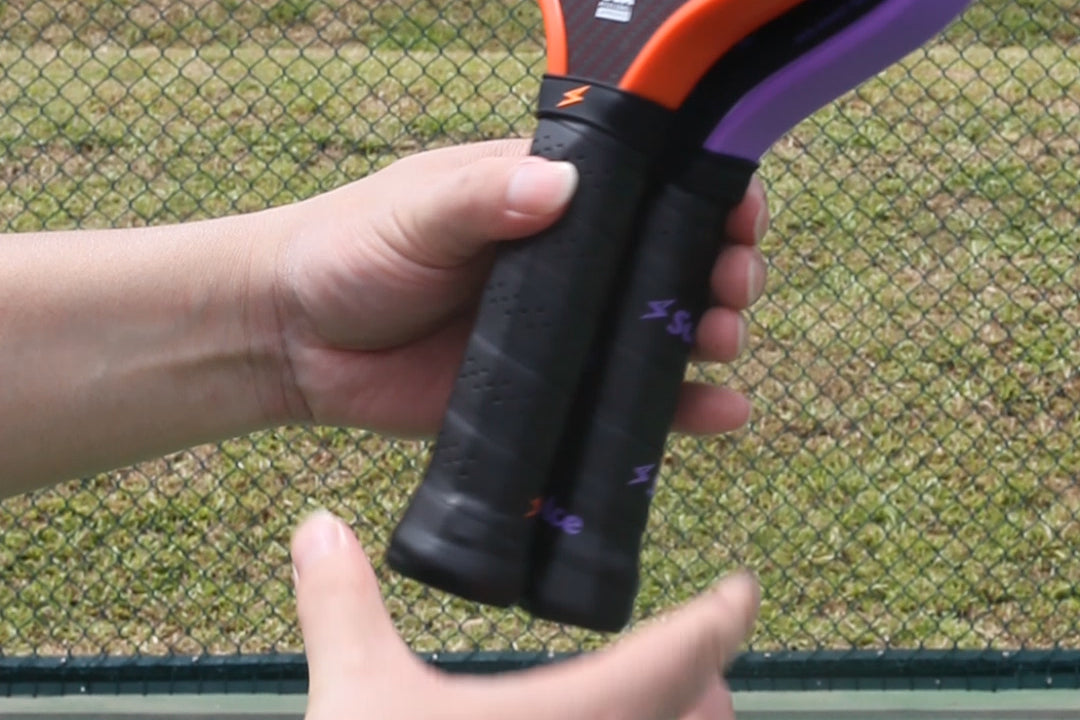The Ultimate Guide to Long Handle vs. Short Handle
Pickleball, a sport that has been rapidly gaining popularity around the world, offers players a unique blend of excitement, strategy, and camaraderie.
While the focus is often on mastering shots and tactics, the equipment used can also play a significant role in a player's performance. One crucial aspect of pickleball equipment is the paddle, and within the realm of paddles, the choice between long and short handles can have a notable impact on gameplay.
In this guide, we'll explore the differences between long and short handles on pickleball paddles, helping players understand their options and make informed decisions when selecting their equipment.
Long Handle vs. Short Handle
Before delving into the nuances of long and short handles, let's clarify what each term refers to.
In pickleball, the total length and width of the paddle can't exceed 24 inches. The handle of the paddle is the portion that players grip while maneuvering and striking the ball.
A long handle typically extends farther down the shaft of the paddle, providing additional length for players to hold onto.
Conversely, a short handle is more compact, offering a shorter grip area but a larger hitting surface and sweet spot.
Grip Preference and Comfort
One of the primary factors influencing the choice between long and short handles is player preference and comfort. Some players may prefer the feel of a longer handle, which allows for a more extensive grip and potentially greater stability. A longer handle can also provide added leverage and control, particularly for players with larger hands or those who prefer a two-handed grip. On the other hand, players who prefer a shorter grip may find that a short handle offers a more compact and maneuverable feel, allowing for quicker wrist action and agility on the court.
Reach and Maneuverability

The length of the handle can also impact a player's reach and maneuverability on the court. A longer handle provides additional reach, allowing players to make shots that might be out of reach with a shorter handle. This can be advantageous for reaching balls that are wide or low, as well as for executing shots with greater power and control.
However, a longer handle may also feel less maneuverable, particularly in tight spaces or when reacting quickly to fast-paced shots.
Conversely, a shorter handle offers greater maneuverability, allowing players to make quick adjustments and react more swiftly to changes in the game. This can be advantageous for players who rely on speed and agility to outmaneuver their opponents or for those who prefer a more compact and streamlined paddle design.
However, a shorter handle may limit reach, making it more challenging to reach balls that are out of the player's immediate vicinity.
Two-Handed Grip
Another consideration when choosing between long and short handles is whether the player prefers to use a two-handed grip. While most players opt for a standard one-handed grip, some may prefer to use a two-handed grip for certain shots or situations.
A longer handle can accommodate a two-handed grip more comfortably, providing ample space for both hands to grip the paddle securely.
This can be advantageous for players who want to generate additional power and control by using both hands to execute shots. However, players who prefer a two-handed grip may find that a shorter handle limits their ability to comfortably grip the paddle with both hands, potentially affecting their shot execution and overall performance.
Weight Distribution and Balance
The length of the handle can also impact the weight distribution and balance of the paddle. A longer handle may shift the balance point of the paddle slightly toward the handle end, resulting in a slightly different feel and balance during gameplay. This can affect how the paddle feels in the player's hand and how it responds to different types of shots.
Conversely, a shorter handle may distribute the weight more evenly throughout the paddle, resulting in a more balanced feel and consistent performance.
Making the Right Choice
The choice between long and short handles on pickleball paddles is ultimately a matter of personal preference and playing style. Players should consider factors such as grip preference, reach, maneuverability, two-handed grip, and weight distribution when selecting a paddle with the right handle length for their needs.
Trying out different paddle configurations and seeking input from experienced players can help players determine which handle length best suits their playing style and preferences.
Whether opting for a longer handle for added reach and stability or a shorter handle for increased maneuverability and agility, choosing the right handle length can enhance a player's comfort, control, and performance on the pickleball court.
By understanding the benefits and trade-offs of long and short handles, players can make informed decisions and choose a paddle that complements their unique playing style and enhances their overall gameplay experience.




